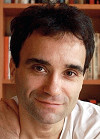
Luis Lopez Molina
Labs 1067 - 1077
+41 22 379 32 06
E-mail
Seed Molecular Genetics
Research Interests
Colonization of land by plants is a major chapter in the history of plant evolution. Appearance of seeds has been essential for this success. A seed consists of a small encapsulated plant in a highly resistant and inert state awaiting favorable growth conditions to germinate and pursue its life cycle.
Seeds convert plants in time and space travelers providing them with protection and allowing their propagation.
However, protection and propagation must be accompanied by germination control mechanisms to avoid potentially fatal starts such as germination out of season or in the face of environmental changes affecting light or water quality. We are interested in understanding the control mechanisms allowing the plant to securely abandon its protective state within the seed.
Key Publications
Iwasaki M., Hyvärinen L., Piskurewicz U. & Lopez-Molina L.:
Non-canonical RNA-directed DNA methylation participates in maternal and environmental control of seed dormancy.
Elife 2019, 8. PMID: 30910007.
Piskurewicz U., Iwasaki M., Susaki D., Megies C., Kinoshita T. & Lopez-Molina L.:
Dormancy-specific imprinting underlies maternal inheritance of seed dormancy in Arabidopsis thaliana.
Elife 2016, 5. PMID: 28005006.
Lee K.P., Piskurewicz U., Turečková V., Carat S., Chappuis R., Strnad M., Fankhauser C. & Lopez-Molina L.:
Spatially and genetically distinct control of seed germination by phytochromes A and B.
Genes Dev 2012, 26(17):1984-96. PMID: 22948663.
Lee K.P., Piskurewicz U., Turecková V., Strnad M. & Lopez-Molina L.:
A seed coat bedding assay shows that RGL2-dependent release of abscisic acid by the endosperm controls embryo growth in Arabidopsis dormant seeds.
Proc Natl Acad Sci U S A 2010, 107(44):19108-13. PMID: 20956298.
Further Reading
Chahtane H., Kim W. & Lopez-Molina L.:
Primary seed dormancy: a temporally multilayered riddle waiting to be unlocked.
Journal of Experimental Botany 2017, 68(4):857–869. https://doi.org/10.1093/jxb/erw377
